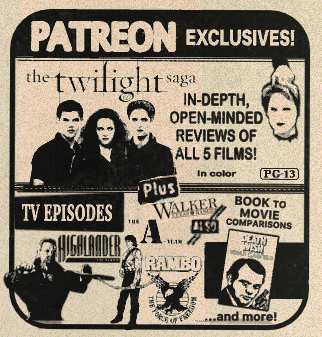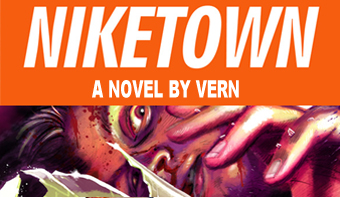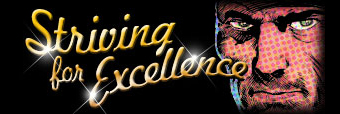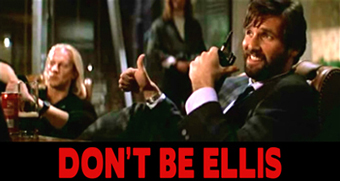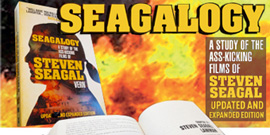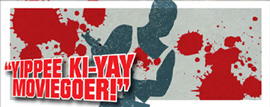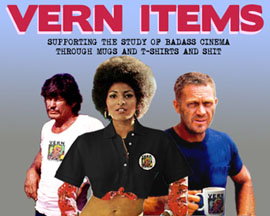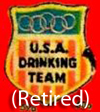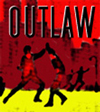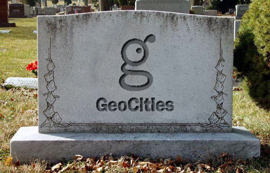Hey, everyone. ”Moriarty” here.
I kid. I know Vern can read. When we first talked all those years ago, when he was fresh out of the pen, he told me that he had to do a lot of reading in prison to break up the monotony of all the gay rape.
No, really, I kid.
Vern, buddy, thanks for doing this one. Good stuff, and my favorite read of the day:
I am here today to review a book. That’s right motherfuckers, I know how to read. The book in question is Action Speaks Louder: Violence, Spectacle, and the American Action Movie (revised & expanded edition) by Eric Lichtenfeld. Our young friend Quint kindly suggested me to review the book and I was happy to check it out.
If you’re like me you’ve never heard of Lichtenfeld before, but you’ve enjoyed some of his work on special features for DVDs such as DIE HARD, PREDATOR, SPEED, and DIE HARD. Turns out he also has a really cool (but not updated enough) action movie blog called Reaction Shot http://reactionshot.blogspot.com/. And not too long ago on slate.com he declared “Yippee-Ki-Yay Motherfucker” the greatest one-liner in movie history http://slate.com/id/2168927/. So we share some interests.
I’ve read a few scholarly studies of horror movies, but I’ve never seen one on action. I know there are some action-centered review books, but as far as I can tell the serious-analytical-study-of-the-action-genre book is fairly new territory. In fact, if you type “action movie” into the amazon search engine, this book is the first one to come up. Go down the list and you won’t find another one that fits the bill until #46, Action and Adventure Cinema.
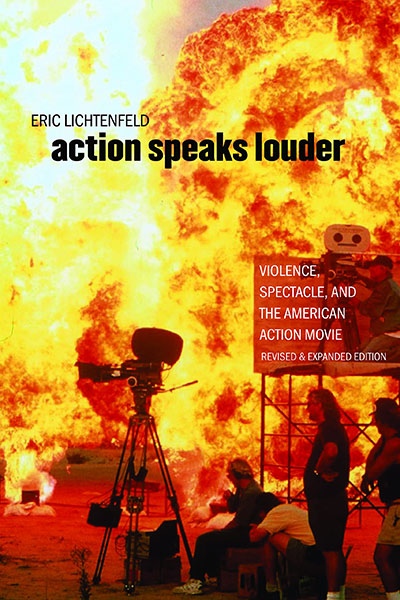 You’re especially gonna have a hard time finding an intelligent study of the genre from the perspective of a fan. Alot of people don’t take it as seriously as we do, they think it’s just supposed to be some dumb fun and they believe in that bullshit about “check your brain at the door.” And the people who don’t believe in that might be the ones that only want to study action movies to complain about their violence or their gender roles or racial stereotypes. Lichtenfeld doesn’t ignore those things, he touches on them, but he states in the introduction that he’s deliberately not focusing on them because those are the aspects of the genre that have been covered already. Instead he gives us an analytical view of the evolving themes and styles of action movies over the years.
You’re especially gonna have a hard time finding an intelligent study of the genre from the perspective of a fan. Alot of people don’t take it as seriously as we do, they think it’s just supposed to be some dumb fun and they believe in that bullshit about “check your brain at the door.” And the people who don’t believe in that might be the ones that only want to study action movies to complain about their violence or their gender roles or racial stereotypes. Lichtenfeld doesn’t ignore those things, he touches on them, but he states in the introduction that he’s deliberately not focusing on them because those are the aspects of the genre that have been covered already. Instead he gives us an analytical view of the evolving themes and styles of action movies over the years.
Rather than trying to go through the movies chronologically, which would’ve been a big mess, he’s divided the genre into a series of trends. So you got chapters like “The Vigilante and Other Myths” (DIRTY HARRY, DEATH WISH), “Rise of the Killing Machines” (both literal like THE TERMINATOR and figurative like RAMBO), and then “Enter the Fists: The Body as the Weapon” which is where he gets into the martial artists like Seagal, Van Damme and Norris. One interesting connection he makes is “Into the Jungle, Out of the Wasteland: Action in the Wild,” where he finds common ground between post-apocalypse movies like the MAD MAX series and jungle-based hostage rescue missions like UNCOMMON VALOR, RAMBO and the MISSING IN ACTION series. But all that is warm up for Chapter 5, “Blowing Up All Those Familiar Places” which brings us to DIE HARD and its bastard sons.
Lichtenfeld considers AIR FORCE ONE to be the last of the DIE HARD cycle, making it in my eyes the end of the golden age of American action. Because as he shows in the later chapters of the book, the genre starts to get away from the simpler stories and iconic characters, more into complicated special effects spectacles, crossbreeding with other movies until the heroes all have super powers or are fighting against aliens or against Mother Nature herself. There are chapters on the crappy disaster movie revival of the ’90s, the sci-fi and horror influenced action movies (reaching from THE MATRIX back to ROBOCOP, with lesser stops along the way such as DOOM and VAN HELSING). And then the last chapter is on super heroes, thankfully spending some good time on BLADE and THE PUNISHER. He shows how those two came out of action movie traditions as much as comic books. But he points out that stuff like SPIDER-MAN and X-MEN is where most of the action scenes end up in American movies these days. The action movie has been crossbred so much that it’s rare to see it straight up anymore. If you do see one you gotta get it papers like a purebred dog.
Lichtenfeld skips around in time but the trends are roughly in order so you see it evolve from Dirty Harry and Paul Kersey to god damn Fantastic Four and Daredevil. So it really reinforced my sinking feeling that the sort of action I love, the type that evolved through the ’70s and ’80s, is a dying art form. Even if, say, Len Wiseman or whoever does a good job of reviving it he might just be some corny nostalgia merchant like that dude from the Stray Cats who’s always pretending he’s in a different time period. Dressing up and doing a facsimile of an art form they buried in a ditch some time after DIE HARD WITH A VENGEANCE came out.
But Lichtenfeld has a more positive outlook, demonstrating how the definition of “action” has been loose since day 1. He points out that Variety categorized various DIRTY HARRY movies as “Police Melodrama,” “Police Crime Melodrama,” “Crime Melodrama” and “Police Actioner.” (Only THE DEAD POOL was “Action.”) But all of these were types of action movies, the popular form of which continues to evolve over time. Dirty Harry becomes John Rambo becomes John McClane becomes Will Smith punching an alien becomes Spider-man. And Lichtenfeld convincingly shows how virtually all of these are still connected to their ancestors in film noir and westerns.
Every time I start whining about modern action movies somebody brings up SPIDER-MAN 2. And I can’t relate because to me there’s a huge difference between, say, the cars hurtling through the air for real in the MAD MAX series and a computer graphic animated to swing over a city in the SPIDER-pictures. But this book showed me how the two are distant cousins, if not creepy twin brothers who finish each other’s sentences and collect weird gynecological tools.
In fact, it’s hard to even settle on a definition of what constitutes an action movie. He chose to focus on American styles (guess he must be talking about the dubbed version of MAD MAX then) which is smart – there are plenty of books on martial arts films, Hong Kong crime, samurai movies and spaghetti westerns, so he’s able to set those aside. He chose to disqualify James Bond movies (another topic already studied to death anyway) and mentions CASINO ROYALE being in production but it was not yet released when the book was written. I’m not sure why he left out the Jason Bourne movies, which are not mentioned in the book at all. I suppose those are in the spy thriller area, but they are obviously full of action scenes and seem at least closer to the old form of action movie than FANTASTIC FOUR does.
Of course when you read a book like this one of the things you’re looking for is to see if he mentions your favorite movies and how his take lines up with yours on various issues facing the genre. So not surprisingly I was excited to see what he would say about Seagal. The big guy gets 3 pages dedicated to him, plus later discussion of UNDER SIEGE in the DIE HARD chapter. Lichtenfeld declares him “a more interesting conjunction of star persona and action film mythos” than Van Damme, so that’s good. He spends some time on the marketing of ABOVE THE LAW, with its insinuations of Seagal having a CIA background, but also touches briefly on how the politics of Seagal’s movies differed from the right-leaning genre of the time, which is one of the things that interests me about him too.
If you’re reading a book about action movies you must be an action movie fan, so you’ve seen alot of the movies discussed. You might find yourself having already noticed what the book points out, or thinking “that’s interesting, I never quite thought of it that way” or at times “well, that’s taking it a little far.” But Lichtenfeld rarely stretches too far into pretension, or if he does then I guess I just like his interpretations. And I love the amount of research he’s done, he’s done a great service there. For example I thought it was really interesting when he demonstrated the ’80s fixation on weaponry by quoting from the press kits. Apparently they thought we’d even want the specifics of the dagger that the villain in COBRA uses: “The dagger is 12 5/8 inches long, with a blade of 440c stainless steel. The handle is made of 6061T6 aluminum which has been anodized black.” As if somebody might say, “Dude! 6061T6! That’s one of my favorite aluminums!”
Lichtenfeld mostly avoids discussing whether he thinks the movies are good or not. He’s interested in the themes of the movies, not some sort of ranking or creating a canon. I like this, because you can always read about DIE HARD or DIRTY HARRY but it’s not every day you find a book that talks about ACTION JACKSON, CHRONICLES OF RIDDICK, DEMOLITION MAN, HARD TARGET, MORTAL KOMBAT. It’s funny to see forgettable movies like DANTE’S PEAK, NAVY SEALS and REPLACEMENT KILLERS immortalized in your local library.
While he tends not to point out if he thinks a movie is crap, I do get the sense that he’s as troubled as I am by the changes in action movie editing. This especially comes through in his discussion of Michael razzafrazzin Bay’s THE ROCK, for which he interviewed editor Richard Francis-Bruce and even calculated the average shot-lengths for some of the sequences. Lichtenfeld compares THE ROCK’s car chase to a car commercial, saying that Francis-Bruce even remembers being told by Bay that he would have the editors from his commercials take a pass at the movie after the film editors. It sounds like that didn’t happen, but somehow they still ended up with, according to Lichtenfeld, “an average shot length of one and a quarter seconds for five unrelenting minutes. And according to Francis-Bruce, this represents a tamer version of the scene than the one originally cut.”
It’s a good book that will make you want to run out and rent a whole bunch of movies. While reading it I ended up re-watching COMMANDO and the MAD MAX trilogy and picking up one I didn’t know about, the POW-rescue-movie UNCOMMON VALOR. This brings me to one nitpick of the book, that the copy editing could be a little better. I am definitely not one to complain about this, but I had to bring it up because I went into UNCOMMON VALOR thinking that Fred Willard would be on a team of badass soldiers hired by Gene Hackman to return to ‘Nam to rescue his son who was left behind. Of course it was really Fred Ward, and I’m always happy to see him in a movie, but it woulda been funnier if it was Fred Willard like the book says.
So anyway, I recommend Action Speaks Louder to my fellow action scholars, and I hope it is not the last of its kind. We need more of this. Also if anyone knows any other good books on the topic please mention them in the talkbacks, along with whatever other “fuck yous” or grammar critiques you gentlemen have for me today.
thanks,
Vern
Originally posted at Ain’t-It-Cool-News: http://www.aintitcool.com/node/33882

